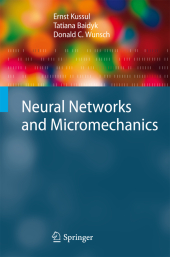 Neuerscheinungen 2014Stand: 2020-02-01 |
Schnellsuche
ISBN/Stichwort/Autor
|
Herderstraße 10
10625 Berlin
Tel.: 030 315 714 16
Fax 030 315 714 14
info@buchspektrum.de |

Tatiana Baidyk, Ernst Kussul, Donald C. Wunsch
(Beteiligte)
Neural Networks and Micromechanics
2010. 2014. x, 221 S. 235 mm
Verlag/Jahr: SPRINGER, BERLIN; SPRINGER BERLIN HEIDELBERG 2014
ISBN: 3-642-42611-5 (3642426115)
Neue ISBN: 978-3-642-42611-7 (9783642426117)
Preis und Lieferzeit: Bitte klicken
This text covers a field of research involving the use of neural network techniques for image recognition to tasks in the area of micromechanics. It includes theoretical analysis, details of machine tool prototypes, and results from various experiments.
Micromechanical manufacturing based on microequipment creates new possibi- ties in goods production. If microequipment sizes are comparable to the sizes of the microdevices to be produced, it is possible to decrease the cost of production drastically. The main components of the production cost - material, energy, space consumption, equipment, and maintenance - decrease with the scaling down of equipment sizes. To obtain really inexpensive production, labor costs must be reduced to almost zero. For this purpose, fully automated microfactories will be developed. To create fully automated microfactories, we propose using arti?cial neural networks having different structures. The simplest perceptron-like neural network can be used at the lowest levels of microfactory control systems. Adaptive Critic Design, based on neural network models of the microfactory objects, can be used for manufacturing process optimization, while associative-projective neural n- works and networks like ART could be used for the highest levels of control systems. We have examined the performance of different neural networks in traditional image recognition tasks and in problems that appear in micromechanical manufacturing. We and our colleagues also have developed an approach to mic- equipment creation in the form of sequential generations. Each subsequent gene- tion must be of a smaller size than the previous ones and must be made by previous generations. Prototypes of ?rst-generation microequipment have been developed and assessed.
Classical Neural Networks.- Neural Classifiers.- Permutation Coding Technique for Image Recognition System.- Associative-Projective Neural Networks (APNNs).- Recognition of Textures, Object Shapes, and Handwritten Words.- Hardware for Neural Networks.- Micromechanics.- Applications of Neural Networks in Micromechanics.- Texture Recognition in Micromechanics.- Adaptive Algorithms Based on Technical Vision.


